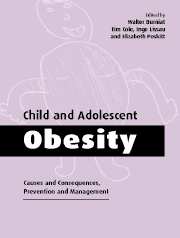Book contents
- Frontmatter
- Contents
- List of contributors
- Foreword
- Preface
- Part I Causes
- 1 Measurement and definition
- 2 Epidemiology
- 3 Molecular and biological factors with emphasis on adipose tissue development
- 4 Nutrition
- 5 Physical Activity
- 6 Psychosocial factors
- Part II Consequences
- Part III Prevention and management
- Index
1 - Measurement and definition
Published online by Cambridge University Press: 02 November 2009
- Frontmatter
- Contents
- List of contributors
- Foreword
- Preface
- Part I Causes
- 1 Measurement and definition
- 2 Epidemiology
- 3 Molecular and biological factors with emphasis on adipose tissue development
- 4 Nutrition
- 5 Physical Activity
- 6 Psychosocial factors
- Part II Consequences
- Part III Prevention and management
- Index
Summary
Introduction
A simple definition of obesity is an excess of body fat. However, as a definition it immediately raises questions – how is body fat measured and what cut-off is used to define ‘excess’? The two questions are addressed in this chapter.
If obesity is an excess of body fat, a more neutral term is needed for the amount of body fat in the body, and here it is called adiposity. Adiposity is the amount of body fat expressed either as the absolute fat mass (in units of kilograms) or, alternatively, as the percentage of total body mass. Fat mass is highly correlated with body mass, while per cent fat mass is relatively uncorrelated with body size.
It is not only the amount but also the distribution of body fat within the body that is important in adults. The distribution or patterning of body fat is associated with later disease risk, independent of the level of obesity (Vague, 1956). Adults with central, trunk or android fat patterning, who are at greater risk (Björntorp, 1985), deposit fat preferentially around the waist, while with gynoid patterning fat is found more towards the extremes of the body.
Some obese adults were fat as children, so child fatness may be a risk factor in its own right for later disease (Power et al., 1997). This is relevant for setting a fatness cut-off.
- Type
- Chapter
- Information
- Child and Adolescent ObesityCauses and Consequences, Prevention and Management, pp. 3 - 27Publisher: Cambridge University PressPrint publication year: 2002
- 17
- Cited by



